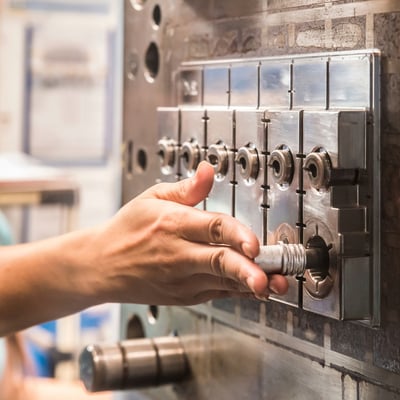 Weighing the pros and cons of the molding process for your composites can help you determine whether it's the right choice for your project needs. Creating a plastic or composite part requires raw material to be heated and poured into a mold that has been created specifically for that part. The four most common types of molding processes are:
Weighing the pros and cons of the molding process for your composites can help you determine whether it's the right choice for your project needs. Creating a plastic or composite part requires raw material to be heated and poured into a mold that has been created specifically for that part. The four most common types of molding processes are:
- Compression
- Injection
- Transfer
- Extrusion
The different molding processes are used to create different pieces. In this article, we’ll be weighing the pros and cons of the injection molding process for thermoset composites.
Pros of Thermoset Injection Molding
Injection molded pieces may be the best fit for a piece for several reasons:
- Many different types of materials may be used in injection molding, including thermoplastic and thermosetting resins, polymers, and elastomers. This offers the engineer a great deal of control over which blend of materials will yield the best outcome, especially when needing to meet specific property requirements.
- Fantastic for high-volume runs.
- Precision and low waste. Because of the specific tooling and material mix, there is less waste with injection-molded parts than with other processes.
- Short cooling time – Injection molded pieces cool quickly, reducing the time required to release the injected piece from the mold.
Cons of Thermoset Injection Molding
While injection molding is a fantastic process for the reasons mentioned above, there are certain limitations and drawbacks. A few of these drawbacks include:
- Tooling costs - These costs can be significant as precision crafted molds are required.
- Flash - Flash is unavoidable when injection molding thermosets. Once the part has been created and ejected from the mold, an automated or manual next step is necessary to remove the flash (excess material). Flash isn’t an issue with thermoplastics due to the higher viscosity of the liquid plastic.
- Part size - The size of the piece being created definitely matters when it comes to the molding process. Typically, smaller part sizes (0.1 lbs to 6 lbs) are injection molded, while larger parts are transfer or compression molded. The volume of the order will also dictate which molding process will be the best fit for the project. Compression molding would likely be used for larger parts with a low (or high) volume, while transfer molding would be used for medium to high volume projects. Injection molding would be ideal for high volume runs with smaller pieces.
In the end, when selecting a molding process for your parts, it’s always recommended to speak with a thermoset composite or thermoplastics engineer. After reviewing your needs, they’ll be best able and equipped to make a recommendation for your job that will produce the highest quality piece at the most reasonable cost.


